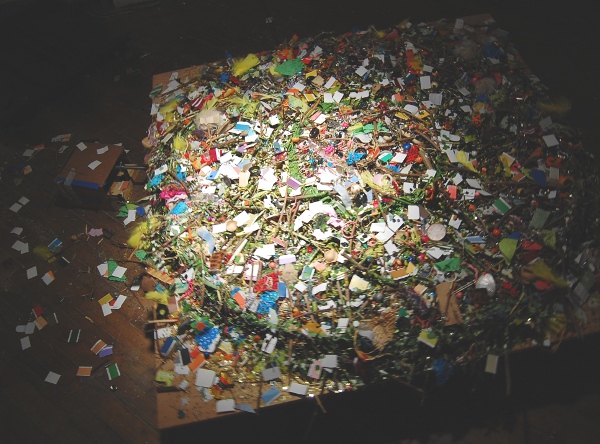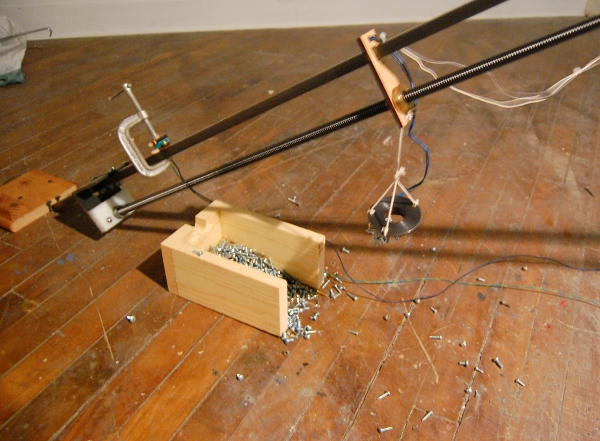
Douglas Irving Repetto’s “Nest Machine” at Marginal Utility
Even before setting foot in the Marginal Utility gallery space, you can hear a strange whirring bouncing out into the hallway. Is there some type of construction project in the adjacent room? Are attendants vacuuming up from the night before? Actually, the answer is none of the above. What is really going on is much, much stranger (and more captivating as well) – an installation of moving parts by New York-based artist Douglas Irving Repetto. The contraption will be at the location through January 20.
Both rooms of Marginal Utility are brimming with inefficient factory components: stitched-together fabric conveyor belts, precarious wooden planks, wavy wires and more than a few loose screws. Part Rube Goldberg, part dystopian assembly line, Repetto’s massive construction not only fills the space, but actively pierces it. A cut out hole in the dividing drywall allows one of the wavering strips of cloth to head directly into the other room as if poor planning had hindered its initial placement.
The end result is a messy nest of loose screws and threads.
What could this all mean, though? Well, the device’s name – “Forever Wild (Nest Machine)” – is a helpful starting point. One set of pulleys spins empty water jugs upside down every so often, depositing bits of colored paper and fabric onto the perpetually moving conveyor belts, while another sends a magnet down a long shaft to gather a number of screws, which it then drops onto the second, wall-transiting belt. Ultimately all of these bits of material travel to the same spinning palette where they are dropped into a circular pattern, creating a sort of haywire nest for some absent creature. The threads are left unstitched and the screws plopped down aimlessly, turning any function squarely on its head.
Jugs deposit bits of cloth and paper onto the moving belts.
In many ways, this machine mimics nature in a very humorous, roundabout sort of way. Like a dutiful mother bird, it tirelessly assembles a nest (although apparently for no good reason whatsoever). In other ways it is perhaps a criticism of consumer goods and unfair labor practices, possibly even technology itself. Aesthetically it looks like a device straight from Terry Gilliam’s “Brazil” and seems to look into the future but also possesses certain nostalgia for untainted nature or times when objects were made by hand.
A magnet hoists screws up to join in the journey.
The parts, although purposely rickety, definitely speak to Repetto’s technical know-how, while also exuding a sense of environmental gravity. Strips of re-purposed cloth and scrap wood become a moving beast of a machine which notes how much effort often goes into the creation of even the simplest trinket. Its sketchy assembly and ultimate uselessness make us wonder about the necessity for much that we own or desire on a day-to-day basis. Is it worth getting the newest gadget or is it possible to repair or reuse the old one? Where do the products we utilize come from and how exactly are they made? Maybe through the questions that Douglas Irving Repetto’s “Nest Machine” raises, it isn’t so useless after all…
Marginal Utility is located on the second floor of 319 North 11th St., Philadelphia; marginalutility.org.
Recent Content
-
Artsarticle ·
-
Artsarticle ·
-
Artsarticle ·




